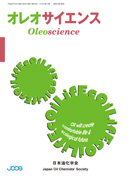
- |<
- <
- 1
- >
- >|
-
-ISO Standards for Biodegradability and Biobased Content, etc.-Masao KUNIOKA2021Volume 21Issue 12 Pages 497-505
Published: 2021
Released on J-STAGE: December 09, 2021
JOURNAL FREE ACCESSMarine pollutions by plastics litter and microplastics are big environmental problems which shall be solved internationally. To solve these problems, 3R (reuse, reduce, and recycle) for plastics products are most important issues, innovations for biodegradable plastics which are used for plastics leaked to environment and biobased plastics which reduce the amounts of fossil-based plastics, are also important. Evaluations for biodegradable and/or bio-based plastics should be based on international standards such as ISO standards which are discussed in ISO Subcommittee SC14 "Environmental aspects" of Technical committee TC61 "Plastics". Marine biodegradation evaluation methods are defined by ISO methods. New functional plastics with good biodegradability in marine, which is produced from biomass, will be evaluated by ISO method. Its market introduction will be promoted by certification of requirements defined in ISO.
View full abstractDownload PDF (928K) -
Hajime NAKAJIMA2021Volume 21Issue 12 Pages 507-515
Published: 2021
Released on J-STAGE: December 09, 2021
JOURNAL FREE ACCESSIt is important for bioplastics resin suppliers to sufficiently transfer technology and pro cess knowledge to converters and manufacturers in order to achieve the successful commercialization of bioplastics. By sharing the right knowledge, processing conditions, and unique characteristics of bi oplastics compared to petroleum-based plastics, the chances of successful commercialization can be improved. The management and control of key business-related factors such as the price of oil, fund management return on investment (ROI) to investors, and regulation and certification requirements are also important factors in bringing bioplastics to the market. In this review article, these issues are presented and discussed with relevant examples. Potential solutions to overcome these issues are also brought forth.
View full abstractDownload PDF (1716K) -
Kotaro INO, Shun SATO2021Volume 21Issue 12 Pages 517-523
Published: 2021
Released on J-STAGE: December 09, 2021
JOURNAL FREE ACCESSDue to problems such as climate change and marine plastic pollution, biodegradable bioplastics have gained growing attention. Polyhydroxyalkanoates (PHAs) are intracellular storage polymers in some bacteria and archaea for energy and can be used as thermoplastics. Particularly, ultrahigh-molecular-weight PHAs, with weight average molecular weight of more than 3 million, have excellent mechanical properties. This review introduces outline of microbial production of ultra-high molecular weight PHAs and mechanical properties.
View full abstractDownload PDF (1009K) -
Tetsuo SAKURAI, Takeharu TSUGE2021Volume 21Issue 12 Pages 525-529
Published: 2021
Released on J-STAGE: December 09, 2021
JOURNAL FREE ACCESSPlastic pollution has become a global concern. The accumulation of plastics in the environment mainly in marine is causing a serious environmental and ecological issue. Polyhydroxyalkanoates (PHAs) are one of the best candidates to be used as a sustainable and biodegradable thermoplastic, instead of using petroleum-based plastics. PHAs are produced from renewable biomass such as sugars and plant oils by bacterial fermentation and show excellent biodegradability even in marine environments. Recently, based on the PHA production, a new culture method for the secretion of the intracellularly synthesized oligoesters from PHA-producing bacteria was developed. The secreted oligoesters are mainly 3 to 7-mers of (R)-3-hydroxybutyrate, capped with an alcohol compound at the carboxy end. The oligoesters have the potential to be used as macromonomers for generating new PHA-based materials. This article reviews the usefulness of PHA as a biodegradable plastic and presents the secretory production of oligoesters from PHA-producing bacteria. Additionally, this article describes the feasibility of the oligoesters for the synthesis of poly(ester-urethane) as a macromonomer.
View full abstractDownload PDF (1595K)
- |<
- <
- 1
- >
- >|